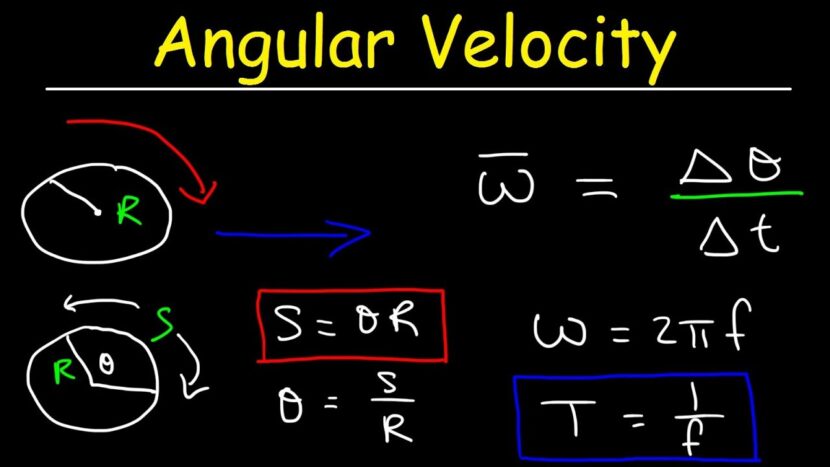
Angular velocity is a critical concept within the realm of physics, and applied technology. It allows for the calculations of the rotating machine, rotating gears, and wheels upon the fixed axis. It also allows for diverse applications within the field of engineering, computer graphics, robotics, and many other applied tech such as game development.
The Angular velocity enables the calculations of the precise control movements, allowing the engineer to understand better the realistic animations, rotating motions, and immersive virtual reality experiences. Now, in this article, we are going to identify the descriptions of the angular velocity equation formula and explore the practical significance of Angular velocity within applied physics and engineering.
Understanding Angular Velocity in Motion
Angular velocity is one of the critical concepts within the field of physics, and it has been implemented in many different fields of physics and technology, for example, mechanical engineering, and robotics.
It is important to understand the Angular velocity in motion to better understand, and then design on many different mechanical as well as engineering projects, especially projects that involve gears, rotation, and many rotating machines.
Angular velocity refers to the rate at which a certain object would rotate, and then spin around the fixed axis (for example, how fast the car wheels would rotate per minute, or how fast the gears would spin within the rotating machine or turbine). It describes the change of angular displacement over time, within seconds or per minute.
Angular displacements represent the angle at which the object rotates and are then measured in radians. To better understand more about the Angular velocity equation then you would need to know more about the measurements as well as the equation.
The Measurement Of The Angular Velocity
Angular velocity is represented by the Omega symbol (ω), and for its measurement, it is typically represented with radians per second or (rad/s) but sometimes there are also other measurements such as Rotation per minute (RPM). This form of foundation is important for realistic simulations, precise control in many tech applications, as well as fluid animations of the rotating machine.
There is also another unit of measurement within the Angular velocity calculations, for example, 1 rotation, and one radian, or degree. Now, the conversion of each unit of measurement can be seen below.
1 revolution = 360 degrees
1 radian = +- 57.3 degrees
Now, if you want to understand more about the Angular velocity measurement, and how to calculate it, let’s see below here, as we can show you how to calculate the Angular velocity.
See also : Why Is Your Car Experience Overheating?
Angular Velocity Calculations And Formula
To calculate the angular velocity in motions, we need to understand the formula on how to calculate it first. The formula for Angular velocity is pretty simple are consists of Angular velocity (omega / ω) is equal to the angular displacement, divided by the time it takes, or changes in time. To help better understand it, here is the formula for it.
ω = ∆θ / ∆t
Explanation:
ω = Angular velocity (in radians per second)
∆θ = Change within angular displacement (in radians sometimes degrees)
∆t = Change within time (in seconds or minutes if it is RPM)
It is important to take note of the constant angular velocity, as it changes in the angular displacement should be directly proportional to its change in time, therefore it would take a constant, non-changing Angular velocity, or stable rotation.
To calculate the Angular velocity equation you can follow this step. First, you need to determine the initial Angular displacement, and then calculate the final angular displacement, This would calculate the change within the angular displacement needed for the formula. Then, calculate the change in initial time, and final time. Calculate the change in angular displacement. This can be done by subtracting the initial angular displacement from the final angular displacement.
Calculate the change of time, and then finally, you can enter the formula to calculate the Angular velocity, the formula of ω = ∆θ / ∆t to determine the angular velocity.
Angular Velocity Applications in Technology, and Engineering Fields
Angular velocity plays quite an important role in various engineering, and physics fields, for example within the robotics field, the Angular velocity would be needed to calculate on the joints, and robotic arms, to enable precise control, as well as the coordination of the robotic joints.
Bellow here, are the examples of the Angular velocity in motion, and their applications within the fields of engineering and technology.
1. Robotics
Just like we have mentioned earlier, one of the most crucial parts within the robotic field is the Angular velocity needed to calculate the robotic joint and arms. By calculating the angular velocity, the robotic engineer could then coordinate the robotic arm and joints, as well as many other moving parts within the robot itself.
2. Computer Graphics, and Animation
Within the realm of computer graphics, angular velocity would also play quite a crucial role, especially to generate realistic movements and animations. How the computer graphic and animator could animate the rotation of objects, and characters, how to angle the camera with precision, and the formula of Angular velocity governs the motion of a 3D model as well.
3. Drone Navigation
Angular velocity is also an essential part of drone navigation and stabilization since it can precisely adjust the angular velocity of the drone propellers, it is one of the key parts of drone mobility and navigation.
Bottom Line
Calculating angular velocity is a crucial step that allows the engineer to understand more about rotational motion, and then apply it to many aspects of physics, and engineering. This would also help to analyze rotational motion and to predict the angle, speed, and orbital rotating objects. By employing the formula, engineers, and researchers could determine the object’s angular velocity.
The applications for the Angular velocity equation range from every day uses such as rotating car wheels, to more advanced physics and engineering projects, such as robotics, astronomy, as well as mechanical engineering. Mastering the concept of the Angular velocity calculations can be invaluable for many different subjects, and fields of physics, engineering, and many other related disciplines.

